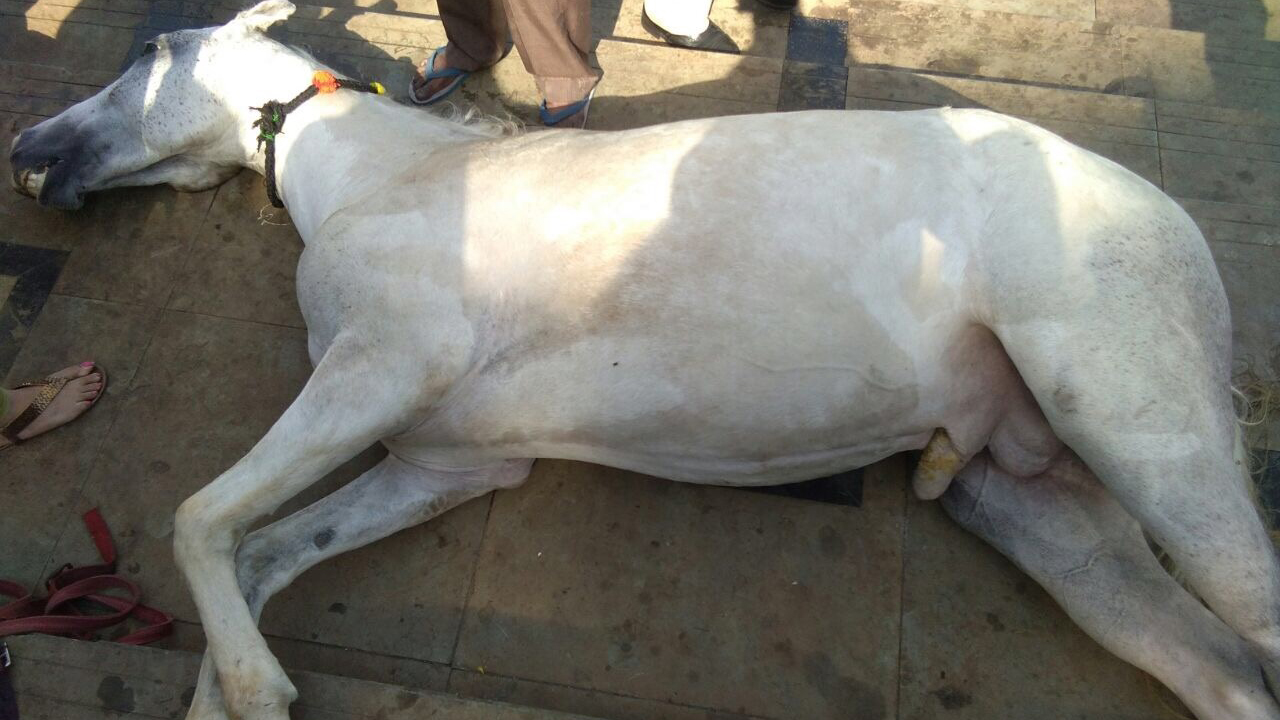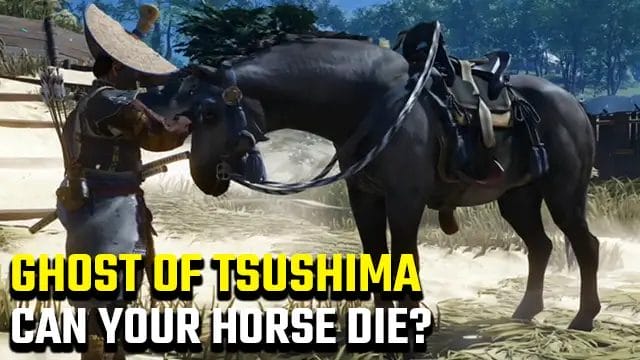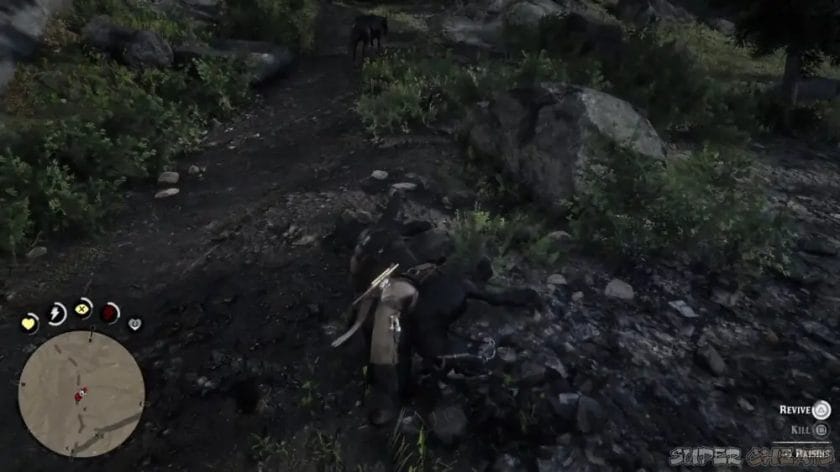Can a horse die from being cast? It is a concerning question among horse owners and enthusiasts.
Being cast refers to a situation when a horse lies down too close to a wall or fence and is unable to stand up again due to the limited space. This can lead to serious complications that may result in the horse’s death.
When a horse is cast, its circulation can be compromised, leading to pressure sores, muscle damage, and even organ failure.
Immediate intervention is crucial to prevent further harm to the horse. Horse owners and caretakers should be knowledgeable about the signs and techniques to help a cast horse.
Regular monitoring and providing a safe environment can significantly reduce the risk of a horse becoming cast and facing potentially fatal consequences.

Signs and Symptoms of a Cast Horse: What to Look Out For
As a horse owner, it is essential to be aware of the signs and symptoms of a cast horse. A cast horse is a term used to describe a horse that has accidentally rolled onto its side and is unable to get back up. This situation can be dangerous and potentially life-threatening for the horse. By recognizing the signs early on, you can take immediate action to help your horse and prevent any further complications.
1. Restlessness and Anxiety
One of the first signs that your horse may be cast is restlessness and anxiety. The horse may be seen pawing at the ground, rolling excessively, or showing signs of distress. This behavior is a result of the horse’s discomfort and inability to free itself from its current position.
2. Sweating and Rapid Breathing
When a horse is cast, it may experience increased sweating and rapid breathing. The horse’s effort to struggle and free itself can cause physical exertion, leading to these symptoms. If you notice your horse sweating excessively or breathing heavily without any apparent reason, it could be an indication that it is cast.
3. Inability to Rise
A cast horse will be unable to stand up on its own. It may repeatedly attempt to get up but fail to do so. Instead, the horse may thrash its legs or roll even more, worsening the situation. If you witness your horse struggling to rise but failing to do so, it is a clear sign of being cast.
4. Visible Injuries and Scrapes
When a horse is cast, it can sustain injuries such as scrapes, cuts, or abrasions. These injuries can occur due to the horse’s struggle against the ground or surrounding objects. Inspect your horse’s body for any visible signs of trauma, which can further confirm its casting condition.
5. Increased Heart Rate
Cast horses often experience an elevated heart rate as a result of the physical exertion and stress they are enduring. You can check your horse’s heart rate by placing your hand on its chest or using a stethoscope. A significantly increased heart rate indicates that your horse is in distress and needs immediate assistance.
6. Agitation and Vocalization
In addition to restlessness, a cast horse might become agitated and vocalize its distress. It may whinny, grunt, or make other distress calls to attract attention. Pay attention to any unusual vocalizations or behavior that could indicate your horse is in trouble.
7. Pinned or Rolled Eyes
When a horse is cast, its eyes may show signs of distress. The eyes might appear rolled back, pinned, or have a frightened expression. This is due to the horse’s discomfort and fear in its current position. Observing changes in your horse’s eye expression can be another indication of casting.
8. Behavioral Changes
A cast horse may exhibit behavioral changes such as aggression, fearfulness, or depression. The stress and pain the horse experiences can impact its temperament and overall mood. Pay attention to any sudden changes in behavior and seek immediate assistance if you suspect your horse is cast.
In summary, recognizing the signs and symptoms of a cast horse is crucial for prompt intervention. Restlessness, sweating, rapid breathing, inability to rise, visible injuries, increased heart rate, agitation, rolled eyes, and behavioral changes are all indicators that your horse may be cast. If you notice any of these signs, it is essential to take immediate action to prevent further harm to your horse and seek veterinary assistance.

Immediate Actions for a Cast Horse: How to Help and Prevent Fatality
A cast horse refers to a situation when a horse lies down and becomes unable to rise on its own. This can be a life-threatening situation, as the horse’s weight compresses its organs and makes it difficult for them to function properly. As a horse owner or caregiver, it is crucial to take immediate actions to help a cast horse and prevent fatality. In this section, we will discuss the necessary steps to assist a cast horse and minimize the risks involved.
1. Assess the Situation
When you come across a cast horse, it is essential to assess the situation carefully. Stay calm and observe the horse’s behavior to determine if it is truly cast or just lying down voluntarily. A cast horse will exhibit signs of distress, such as kicking, rolling excessively, or struggling to get up.
2. Call for Assistance
If you confirm that the horse is cast, immediately call for assistance. Inform a veterinarian or an experienced horse handler about the situation. It is crucial to have additional help to ensure the safety of both the horse and the people involved. Time is of the essence, so a prompt response is vital.
3. Clear the Area
Before attempting to help the cast horse, make sure the surroundings are safe. Remove any obstacles, such as buckets, poles, or sharp objects, to prevent further injury to the horse or yourself. Keep other horses or animals away from the area to avoid potential accidents or disruptions.
4. Protect Yourself
While helping a cast horse, it is crucial to prioritize your safety. Wear appropriate protective gear, such as gloves and sturdy boots, to prevent any injuries. A distressed horse may kick out or thrash, so maintaining a safe distance and being vigilant is essential to avoid harm.
5. Evaluate the Horse’s Condition
Once the area is secure, carefully approach the cast horse and evaluate its condition. Look for any visible injuries or signs of pain. If you notice any severe injuries or suspect a possible fracture, it is advisable to wait for professional assistance rather than attempting to move the horse on your own.
6. Determine the Best Approach
Depending on the horse’s size, strength, and level of distress, you need to decide on the most appropriate approach to help it get up. One common method is to use a webbing strap or a soft rope to create a makeshift sling around the horse’s body. This can help provide support and assist in lifting the horse without causing further harm.
7. Lift Carefully
If you opt to use a sling, slowly and gently lift the horse using a hoist or by pulling the straps. It is crucial to lift the horse in a controlled and steady manner to avoid causing unnecessary stress or injury. Avoid using excessive force or sudden movements, as this can worsen the situation.
8. Encourage Movement
Once the horse is successfully lifted, encourage it to move and regain its balance. Gradually release the pressure from the sling while providing gentle support and guidance. Allow the horse to take its time to adjust and ensure it can stand steadily before completely removing the sling.
9. Monitor the Horse’s Recovery
After helping a cast horse, closely monitor its recovery process. Observe its behavior, breathing, and overall condition for any signs of distress or complications. If necessary, seek veterinary attention to ensure the horse’s well-being and address any underlying health issues that may have contributed to the casting incident.
10. Preventative Measures
While immediate actions are crucial, it is equally important to implement preventative measures to minimize the risk of a horse becoming cast in the future. Some preventative measures include:
- Maintain a suitable bedding depth in the horse’s stall or resting area to provide a soft and stable surface.
- Ensure proper diet and exercise to keep the horse physically fit and maintain healthy muscle tone.
- Regularly inspect the horse’s environment for any potential hazards or obstructions that could contribute to a casting incident.
- Implement a routine turnout schedule to allow the horse ample time to move and stretch its body.
In summary, immediate actions are crucial when dealing with a cast horse. Assessing the situation, calling for assistance, and taking steps to protect yourself and the horse are essential. Using a sling or hoist to lift the horse carefully, encouraging movement, and monitoring its

4. Preventing Horse Casting: Tips and Strategies for Safe Stable Management
Horse casting, also known as being cast, refers to a situation where a horse gets stuck against a wall or in a narrow space and is unable to get back up on its own. This can be a dangerous and potentially life-threatening situation for the horse if not promptly addressed. As a responsible horse owner or stable manager, it is crucial to take preventive measures to minimize the risk of horse casting. In this section, we will discuss some helpful tips and strategies for safe stable management to prevent horse casting incidents.
1. Provide Adequate Space
One of the primary factors that contribute to horse casting is inadequate space within the stable. Horses need sufficient room to move around comfortably, lie down, and get up without getting trapped against a wall. Ensure that your stables are appropriately sized to accommodate the size and movements of the horses housed within them. Avoid overcrowding the stables and provide enough space for each horse to stand, lie down, and roll freely.
2. Use Proper Bedding
The type and amount of bedding used in horse stalls can also have an impact on casting incidents. Choose a bedding material that provides good traction and cushioning, such as straw or shavings. Avoid using slippery or excessively compacted bedding that can make it difficult for horses to regain their footing if they fall or get stuck.
3. Regularly Inspect and Maintain Stables
Regular inspections and maintenance of the stable facilities are essential to identify any potential hazards or risks that can lead to horse casting. Check for loose boards, protruding nails, or any sharp edges that could potentially injure a horse. Repair or replace any damaged infrastructure promptly to ensure a safe environment for the horses.
4. Install Safe Stall Features
Consider installing certain features in the stalls that can help prevent horse casting. Some options include adding angled bars or guardrails along the walls to prevent the horses from getting too close and becoming trapped. Additionally, providing ample lighting in the stables can help horses navigate their surroundings more easily and reduce the chances of casting incidents.
5. Properly Train Staff and Handlers
Proper training and education of staff and handlers is crucial for preventing horse casting. Ensure that everyone working with the horses is knowledgeable about the signs of casting, how to safely handle and assist a cast horse, and the appropriate steps to take in case of an emergency. Regularly conduct training sessions and refresher courses to keep everyone up to date with the best practices.
6. Supervise Horses During Turnout
When horses are turned out for exercise or grazing, it is important to supervise them to minimize the risk of casting. Keep a close eye on their behavior and movement patterns to identify any signs of distress or potential casting situations. If a horse appears stuck or unable to get up, prompt intervention and assistance can be crucial in preventing further complications.
7. Consult with Veterinarians
Veterinarians can provide valuable insights and guidance on preventing horse casting incidents. Regularly consult with a veterinarian to assess the overall health and well-being of the horses in your care. They can recommend specific measures or adjustments based on individual horse needs and behaviors to mitigate the risk of casting.
By implementing these tips and strategies for safe stable management, you can significantly reduce the chances of horse casting incidents and ensure the well-being of your equine companions. Remember, prevention is always better than dealing with a potentially dangerous situation, so prioritize proactive measures to create a safe and secure environment for your horses.
When to Call a Veterinarian: Recognizing Emergency Situations for Cast Horses
As a horse owner or caretaker, it is important to be prepared for emergency situations that may arise, especially when your horse becomes cast. When a horse is cast, it means that it is lying on its side and is unable to get up. This can be a serious situation and requires immediate attention. Knowing when to call a veterinarian is crucial in order to provide the necessary care and ensure the well-being of your horse.
Recognizing a Cast Horse
Before understanding when to call a veterinarian, it is vital to be able to recognize when a horse is cast. Some common signs of a cast horse include:
- Lying on its side for an extended period of time
- Thrashing or struggling to get up
- Visible signs of distress or discomfort
- Difficulty breathing
- Sweating excessively
- Pawing at the ground
If you come across a horse displaying any of these symptoms, it is important to act quickly and assess the situation in order to determine if emergency veterinary care is required.
When to Call a Veterinarian
While not every instance of a cast horse requires immediate veterinary assistance, there are certain situations in which it is crucial to call a veterinarian right away. These include:
- If the horse is unable to get up after several attempts
- If the horse appears to be in significant distress or pain
- If there are visible injuries or bleeding
- If the horse is exhibiting difficulty breathing or is choking
- If the cast horse is a foal or young horse
- If the horse is experiencing a medical condition or has a history of health issues
In these cases, it is important not to delay in seeking professional help. Calling a veterinarian immediately can increase the chances of a successful outcome and prevent further complications.
What to Do While Waiting for the Veterinarian
While waiting for the veterinarian to arrive, there are a few steps you can take to assist the cast horse:
- Clear the area around the horse to prevent further injury
- Provide a soft bedding under the horse to relieve pressure on its body
- Offer water to keep the horse hydrated
- Remove any halters or equipment that may be restricting the horse’s movement
- Do not attempt to physically force the horse to stand up, as this can cause more harm
Remember, do not delay in contacting a veterinarian while performing these tasks. It is essential to provide the necessary care as soon as possible for the well-being of the cast horse.
Summary
Recognizing emergency situations for cast horses is crucial for horse owners and caretakers. Being able to identify the signs of a cast horse, knowing when to call a veterinarian, and taking appropriate actions while waiting for veterinary assistance are all important factors in providing the necessary care for your horse. By acting promptly and seeking professional help when needed, you can ensure the best possible outcome for your cast horse.
FAQs
Can a horse die from being cast?
Yes, a horse can die from being cast if it remains trapped for an extended period. Being cast refers to when a horse rolls or lies down and gets stuck against a wall or object, unable to get up. This can cause severe internal injuries or compression of important organs, leading to death.
Conclusion:
In conclusion, the condition of a horse being cast, which refers to when a horse is unable to free itself after lying down, can indeed be life-threatening. Horses in this situation are at risk of causing internal injuries, such as organ damage or respiratory problems, which may lead to death if not addressed promptly. It is crucial for horse owners and handlers to be vigilant and take immediate action to help a cast horse. Timely intervention, along with the assistance of experienced professionals, can greatly improve the chances of a horse’s recovery and prevent a potentially tragic outcome.

